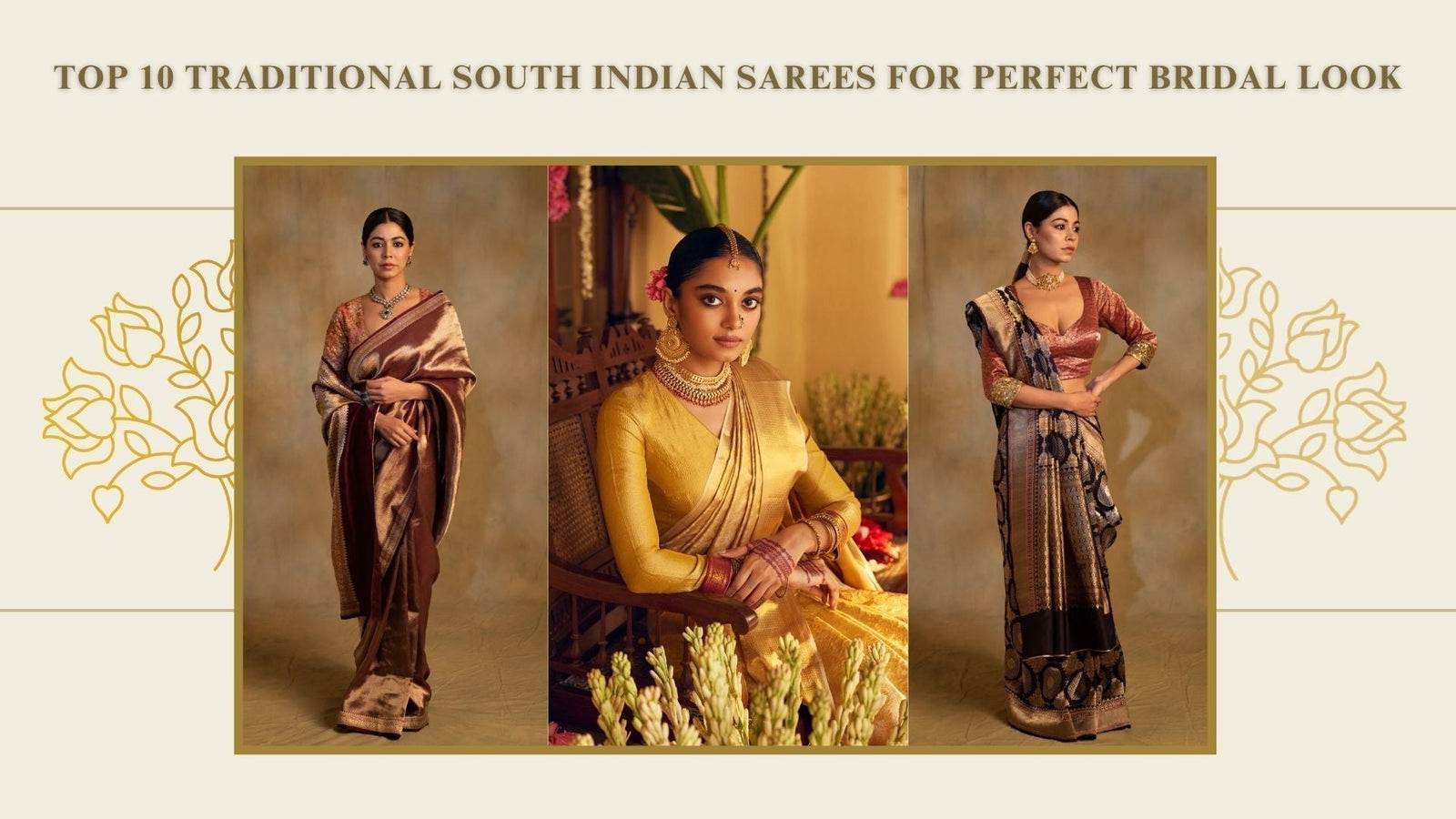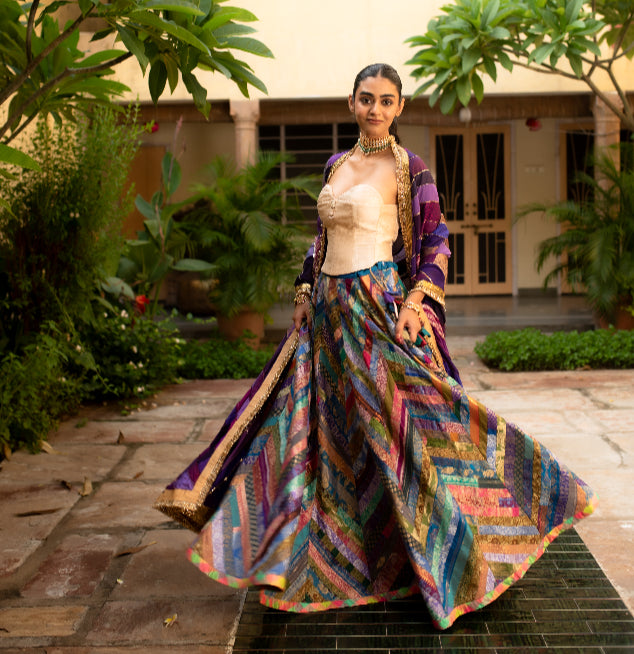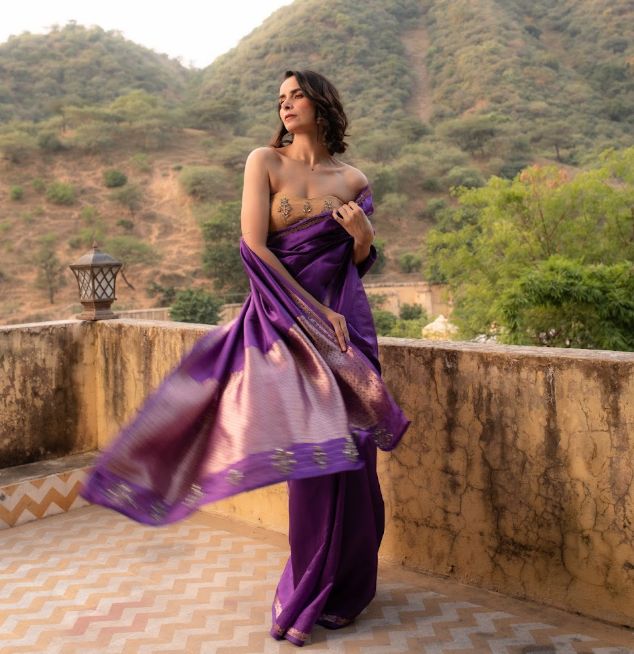Top 10 Traditional South Indian Sarees for the Perfect Bridal Look

Introduction: The Culture of South Indian Bridal Sarees
The rituals, the song, and the laughter. Every Indian wedding has its stars. But nothing is more impactful and lasting than what the bride wears. In South Indian culture, it would be a saree, and not just any saree, but an actual silk saree designed with luxury, symbolism, and effort. The South Indian bride has long been familiar with the beauty and poise of silks and cottons, as well as the mythical sarees from Tamil Nadu, Karnataka, Andhra Pradesh, and Telangana, which have aptly draped brides with poise.

There is a quality that is attached to these sarees that comes from the sheer beauty and poise, and the handicraft that is attached to them. Kanchipuram silks are woven using threads so resilient, legend has it, that you cannot hand-tear one! Mysore silk is India's purest silk and has been woven since royalty reigned. But at Priyanka Raajiv, we honour this legacy with sarees that blend traditional methods with contemporary elegance—bridal wear cut to carry tales into the future.
Why South Indian Sarees Are Best for Every Bride?

When a bride selects her wedding saree, she's not exactly purchasing cloth—she's purchasing comfort for a day-long ritual schedule, durability for a family heirloom, and symbolism expressing blessings on her marriage. South Indian sarees fulfil all three.
They are known for:
-
Weaving traditions that have been practised for centuries.
-
Luxurious silks and zari that give both grandeur and longevity.
-
Motifs and colours steeped in auspicious meaning, from peacocks symbolising love to gold borders signifying prosperity.
And when curated with care, as seen in the bridal collections at Priyanka Raajiv, these sarees are elevated into masterpieces—each one timeless, yet styled for today’s bride.
10 Best Traditional South Indian Sarees for Brides
Across South India, each weaving cluster has its own masterpiece. When a bride chooses all her wedding preparations, she is not really choosing any fabric. She is choosing three aspects of life: comfort in a long day of rituals, durability to be passed on as an heirloom, and symbolism into which blessings for their marriage are poured.
Some sarees are loud and grand, whereas others are light and elegant for the icing of any wedding function. Together, they create a menu no bride can resist.
The following are ten sarees that still significantly characterize the South Indian bridal trousseau:
1. Kanchipuram (Kanjivaram) Silk Saree

Kanchipuram silk sarees are Tamil Nadu's own, and they are renowned for their lovely texture and design. Genuine mulberry silk is maintained to be kept in these sarees, with heavy zari work (peacocks, temples, and flower motifs in gold or silver), putting a royal touch onto it.
An interesting difference from other types of silk-weft weaving is that, in the Kanjivaram method, the body and the border are woven separately and then interlocked together—a technique that speaks for its sturdiness and feel. Being a Geographical Indication product, an authentic Kanjivaram saree must be made only in Kanchipuram, implying that the traditional weaving method has a life.
2. Mysore Silk Saree

Mysore silk sarees, born in the state of Karnataka, possess the lightness of being light, which gives a radiant beauty to the person. Mysore silk sarees are made from pure mulberry silk, and, at times, Kasuti embroidery is incorporated, which is hand embroidery done in Karnataka. The pattern for the embroidery work is done in lamps, birds, and chariots, which provides elegance to the saree with cultural value. The drama of fabric, combined with quality soft draping and comfort, leads Mysore silk to take its position as a wear for long ceremonial or special occasions since it enables the bride to look elegant.
3. Kerala Kasavu Saree

Kerala Kasavu may be touted as the absolute picture of simplicity and elegance. Having cream or off-white colours, it goes with a golden zari strip. Historically, this saree had been worn at Onam festivals and was symbolic of Kerala culture. The use of fine golden or silver threads in weaving is but a little decoration on an otherwise plain design.
4. Gadwal Saree

Gadwal sarees are a unique blend of cotton and silk with a touch of Andhra Pradesh. The base of the saree is said to be woven with very fine cotton and is usually bordered and given a pallu in silk with somewhat complicated zari work. The effect is a very light and luxurious fabric. The ancient kuttu method is peculiar to Gadwal, whereby they weave the body and borders separately and then join them so as to give great strength and neat finishing to every piece.
5. Dharmavaram silk saree

The majesty and ceremonial value associated with Dharmavaram silk sarees have rendered them extremely prominent in Andhra Pradesh. The saree is made of pure silk and adorned with gold zari borders and designs of several kinds, like religious and temple themes. With a heavy fall and glossy finish, the drape becomes the bridal wear in pursuit of an old-age traditional yet luxurious quality.
6. Pochampally Ikat Saree

In total, the geometric patterns will take their inspiration from tribal art, temple architecture, and leaves, thereby indicating the rich culture of the nation. When these are woven into silk or cotton, it's the Pochampally Saree that completes the bridal look by marrying classical designs with modern expression: an ideal outfit for those expecting to tread an unorthodox path.
7. Konrad Saree

Konrad sarees are from Tamil Nadu, and the sectors are emphasised with checks or simple stripes, with wide borders of zari and detailed embroidery in gold threads on the pallu decorations. Thus, the blend of subtle colours with splendid adornments achieves the balance between simplicity and grandeur. These designs, traditionally known as 'kampi' or 'pettu,' bear narrow supplementary warp patterning bands that are woven into the fabric. The weaving technique adds an extra feel of texture to the finish; it almost appears three-dimensional.
8. Koorai Silk Saree

A Koorai silk saree is a traditional nine-yard-long saree from Tamil Nadu, generally worn by the bride on the wedding day. Woven of pure silk, these sarees have checks of striking colours like turmeric yellow, deep pink, or green. The nine-yard length of the saree provides for a variety of draping styles that enhance the appeal and cultural value of this wear. The Koorai saree holds a special position in Tamil weddings, brimming with tradition and elegance.
9. Tussar Silk Sarees

Tussar silk sarees are light in weight and have a natural sheen. Their lightweight nature makes them more gracious to brides in search of style without the hassles. These are fashioned by the silk of tussar moths, usually in earthy colours and warm, muddled prints. Design flexibility gives the saree its own identity. Tussar contains natural auburn shades with a light sheen that imparts a drop of sophistication.
10. New Age Kanjivaram Variants

New-age brides are going in for new-age versions of the classic kanjivaram by picking pastels, whites, and silvers instead of the traditional red and letting the rich silk and zari thread do the rest. The exclusive detail provides greater room for maneuver, as the lightness of the saree presents an extremely light threat to modesty.
Enabling each bride to infuse her own individuality into the look of the sarees, these are draped in a contemporary manner, incorporating all the traditional methods. Each weave has tales to share, and at Priyanka Raajiv, one-on-one curation ensures that the brides do not merely adorn a saree but a story where tradition and design converge.
How to Select the Right South Indian Saree for the Wedding?

With so many beautiful sarees available at one's choice, the decision is often more than mere appearance. Brides take into account numerous factors, ranging from comfort to family customs and maybe even the time of year when the wedding is taking place.
Some guidelines worth recalling are:
Colour Choices: Red, maroon, and gold continue to be auspicious, and pastel pink and jewel tones provide a modern touch.
Season: Cotton-silk weaves during summer; heavy silks during winter.
Heritage: Sarees from your own country are sentimental.
Durability: Pieces of pure zari and quality silk make an heirloom.
At Priyanka Raajiv, each saree is designed with the above factors in mind, where heritage gets fused with a well-thought-out design done for the present bride. The collections reinterpret these antique pieces with new details to make each one a truly bespoke attire.
Conclusion
A South Indian wedding saree is not a purchase to be made overnight; it is a memory, an heirloom, and a celebration of craftsmanship. Each drape, whether regal Kanchipuram or merely chic Mysore silk, is filled with a whole history. At Priyanka Raajiv, those histories are turned into modern heirlooms by means of craft, sustainable practices, and design that pay homage to legacy. Every piece is filled with significance that speaks of the Artistry of Indian heritage to you.
FAQs
Q1: What colours are ideal for South Indian brides?
Ans: Red, gold, and maroon are historically favourable, although jewel colours and pastels are being picked more and more by contemporary brides.
Q2: What is the typical price bracket for bridal South Indian sarees?
Ans: Most fall between ₹15,000 and ₹2,00,000, depending upon fabric quality, intricacy of weaving, and zari purity.
Q3: Is it possible to use a South Indian saree for a North Indian wedding?
Ans: Yes. The majesty and artistry of South Indian sarees make them an appropriate garment for weddings in India.

